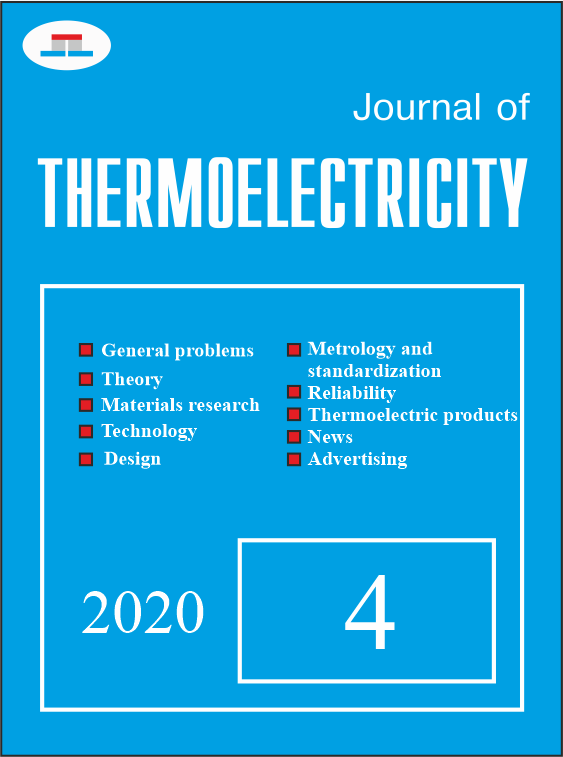Temperature resolution of computer-integrated polarization thermal imager
Keywords:
polarization thermal imager, energy resolution, noise equivalent temperature difference, degree of polarizationAbstract
The work is devoted to the development of a method for determining the energy (temperature) resolution of a polarization thermal imager, which contains a linear polarizer and a phase plate. For this purpose it is proposed to use the noise equivalent temperature difference (NETD). A physico-mathematical model of an optoelectronic system of the polarization thermal imager has been developed, which allows one to calculate its signal transmission function. Based on this function, a method for calculating NETD has been developed. The formula describing functional dependence of a polarization thermal imager temperature resolution on the angular orientation of the polarizer relative to the optical axis of the phase plate at a given degree of polarization is obtained. A study of the impact of a test object radiation degree of polarization on the polarization thermal imager temperature resolution was performed. Bibl. 8, Fig. 7, Tabl. 1.
References
Goldstein D.H. (2011). Polarized light. 3d ed. London - New York: CRC Press.
Born M.,Wolf E. (2002). Principles of optics, 7th ed. Cambridge University.
Yanga Bin, Wub Taixia, Chenc Wei, Lic Yanfei, Knjazihhind Juri, Asundie Anand, Yan Lei (2017). Polarization remote sensing physical mechanism, key methods
and application. The International Archives of the Photogrammetry, Remote Sensing and Spatial Information Sciences. Vol. XLII-2/W7, Wuhan, China.
Zhang Y., Shi Z.G., Qiu T.W. (2017). Infrared small target detection method based on decomposition of polarization information. J.of Electronic Imaging, T 33004, №1.
Fizicheskii entsyklopedicheskii slovar’ [Physical encyclopedic dictionary] (1984). A.M.Prokhorov (Ed.). Moscow: Soviet Encyclopedia [in Russian].
Vollmer M., Karstadt S., Mollman K.-P., Pinno F. (2001). Identification and suppression of thermal imaging. InfraMation Proceedings. University of Applied Sciences, Brandenburg (Germany). ITC 104 A.
Zhao Yongqiang, Yi Chen, Kong Seong G., Pan Quan, Cheng Yongmei (2016). Multi-band polarization imaging and applications. National Defense Industry Press, Beijing and Springer-Verlag Berlin Heidelberg.
Gurton K.P., Yuffa A.J., Videen G.W. (2014). Enhanced facial recognition for thermal imagery using polarimetric imaging. Optical Society of America, 39(13), 3857–3859.
Sivukhin D.V. (2004). Obshchii kurs fiziki [General physics course]. 4th ed. Moscow: MFTI [in Russian].
Anatychuk L.I., Vikhor L.M., Kotsur M.P., Kobylianskyi R.R., Kadenyuk T.Ya. (2016).
Optimal control of time dependence of cooling temperature in thermoelectric devices. J.Thermoelectricity, 5, 5-11.
Kolobrodov V.H., Mykytenko V.I., Tymchyk H.S. (2020) Poliaryzatsiina model teplokontrastnykh obiektiv sposterezhennia [Polarization model of heat-contrast objects of observation]. J.Thermoelectricity, 1, 36-52.
Vollmer Michael, Mollman Klaus-Peter (2018). Infrared thermal imaging. fundamentals, research and applications. 2nd ed. Weinheim: Wiley – VCH.
Kolobrodov V.G., Lykholit M.I. (2007). Proektuvannia teploviziinykh i televiziinykh system sposterezhennia [Design of thermal imaging and television surveillance systems]. Kyiv: KPI [in Ukrainian].
Chrzanowski K. (2010). Testing thermal imagers. Practical guidebook. Military University of Technology, 00-908 Warsaw, Poland.
Lloyd G. (1978). Thermal imaging systems. Moscow: Mir [Russian transl].
Kolobrodov V.G. (2020). Determination of transmittance of optical system of polarizing thermal imager. Visnyk NTUU KPI Seriia – Radiotekhnika Radioaparatobuduvannia, 78,
–85.
NATO Military Agency for standardization (1995). Definition of nominal static range performance for thermal imaging systems.
Khrebtov I.A., Maliarov V.G. (1997). Neokhlazhdaiemyie teplovyie metrichnye priiomniki IK izlucheniia [Uncooled thermal array IR detectors]. Soviet Journal of Optical Technology, 6, 3–17 [in Russian].
Tymchik G.S., Kolobrodov V. H., Kolobrodov M. S., Vasyura Anatoliy S., Komada Paweł, Azeshova Zhanar. (2018). The output signal of a digital optoelectronic processor. Proc. SPIE 10808, Photonics Applications in Astronomy, Communications, Industry, and High-Energy Physics Experiments 2018, 108080W (1 October 2018).




